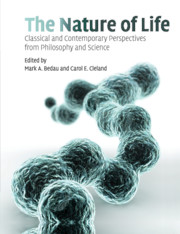Book contents
- Frontmatter
- Contents
- Preface
- Acknowledgments
- Sources
- About the authors
- Introduction
- SECTION I CLASSICAL DISCUSSIONS OF LIFE
- 1 De Anima (selections)
- 2 Treatise on Man
- 3 Critique of the teleological power of judgment (selections)
- 4 What is Life? (selections)
- 5 The nature of life
- 6 What is the meaning of “life”?
- 7 The principles of life (selections)
- SECTION II THE ORIGIN AND EXTENT OF NATURAL LIFE
- SECTION III ARTIFICIAL LIFE AND SYNTHETIC BIOLOGY
- SECTION IV DEFINING AND EXPLAINING LIFE
- Supplementary bibliography on life
- Index
- References
5 - The nature of life
Published online by Cambridge University Press: 10 November 2010
- Frontmatter
- Contents
- Preface
- Acknowledgments
- Sources
- About the authors
- Introduction
- SECTION I CLASSICAL DISCUSSIONS OF LIFE
- 1 De Anima (selections)
- 2 Treatise on Man
- 3 Critique of the teleological power of judgment (selections)
- 4 What is Life? (selections)
- 5 The nature of life
- 6 What is the meaning of “life”?
- 7 The principles of life (selections)
- SECTION II THE ORIGIN AND EXTENT OF NATURAL LIFE
- SECTION III ARTIFICIAL LIFE AND SYNTHETIC BIOLOGY
- SECTION IV DEFINING AND EXPLAINING LIFE
- Supplementary bibliography on life
- Index
- References
Summary
THE EXTENT OF LIFE
LIFE—the word is so easy to understand yet so enigmatic for any thoughtful person. One would have thought that the meaning of this word would have been clear and the same for all ages and all peoples. Nevertheless, we know that, during the many centuries of human cultural history, there have been irreconcilable conflicts as to how it should properly be understood.
Even the question of what is alive, which of the objects in the world around us are imbued or endowed with life, the extent of the realm of life or its scope, have been defined and are still defined in various totally different ways. We have, as it were, a whole multicoloured spectrum of different opinions. At the one end of this spectrum we find the views of those philosophers and scientists who believe that life is a general property, inalienable from all matter, and who therefore extend the realm of life to cover all objects in the universe.
On the other hand, the philosophers of the opposite end of the spectrum arbitrarily restrict the scope of life to the compass of human existence, or may even maintain that life is the prerogative of one single thinking subject.
The first of these opinions owes its origin to the ancient Greek hylozoists. According to Aristotle, even Thales the founder of the Miletian school of philosophy (who was alive about 600 bc) considered magnets to be animate on account of their ability to attract iron.
- Type
- Chapter
- Information
- The Nature of LifeClassical and Contemporary Perspectives from Philosophy and Science, pp. 70 - 87Publisher: Cambridge University PressPrint publication year: 2010
References
- 2
- Cited by



